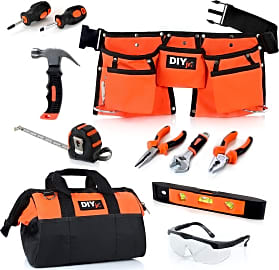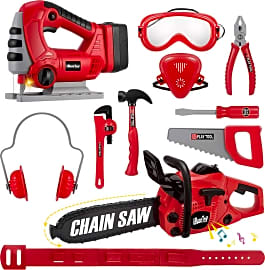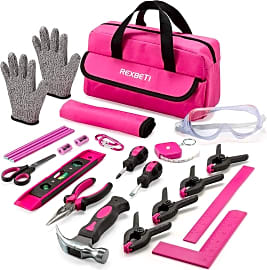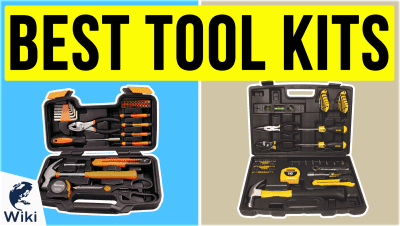The 10 Best Kid's Tool Sets

This wiki has been updated 43 times since it was first published in October of 2015. Kids love to imitate their parents, so let your little ones tinker away, just like mom or dad does, with one of these tool sets. Coming in bright hues with a variety of fun ways to play, your young builder will never know that he or she is developing important fine motor skills, hand-eye coordination, and color recognition. Many of them even come with toolboxes or bags for convenient storage. When users buy our independently chosen editorial recommendations, we may earn commissions to help fund the Wiki.
Editor's Notes
October 26, 2020:
During this round of updates, we wanted to ensure that we maintained a balance of toys for different ages ranges. For this reason, we kept the Melissa & Doug Wooden Take-Along and the Green Toys Blue, which are ideal for promoting fine motor skills in toddlers. These are the only two items on the list that are suitable for those under three years old. We also added the Gifts2U for Boys and Girls for slightly older little ones, which we felt had good potential for encouraging imaginative play, while simultaneously developing hand-eye coordination, dexterity, and other motor skills. Kids can make cars, tanks, or windmills from the construction panels provided, much like an easy form of K'Nex.
Moving up through the age groups, the iBaseToy Realistic and the Kidzlane Durable, are great for children who want more lifelike and useful toys, but aren't yet ready to be handling the real thing. With its chainsaw, headphones, and dust mask, the former caters to youngsters who dream of taking on big jobs, whereas sporting a hammer, pliers, and a screwdriver, the latter is well-suited to kids who like pretending to fix things around the house.
For big boys and girls, who not only want to imitate their parents but also want to actually create something, the DIY Jr. Steel Forged, which remained on the list from last time, the Hi-Spec DIY, and the Rexbeti 0800 should all do the job. All three options are durable and are designed as real tools for small hands, and as such, they each require adult supervision and appropriate safety equipment when using them.
May 29, 2019:
For this latest update, we had to let our previous #7 pick EduKid Toys go due to unavailability. We added the comprehensive Young Choi's Construction instead, and placed it in the top spot due to its excellent construction and transformable working bench. We were impressed with the attention to detail this set employed - more than simply including typical tools (hammer, drill, saw, etc), this kit boasts thoughtful items like insulated pliers, a dust mask, putty knife, and much more.
We also took the opportunity to swap our old #3 choice, the Fisher-Price Drillin' Action, out with its newest iteration. While the updated version no longer comes with a hammer, it's drastically less expensive than its predecessor, which we feel makes up for the loss.
We also wanted to ensure this list had eco-friendly selections, (the Green Toys Blue and Wonderworld Bench-N-Box) as well as at least one genuine set (the DIY Jr. Steel Forged) for parents who are serious about teaching their children how to DIY.
Special Honors
Highland Woodworking Kit For parents who are serious about teaching their youngsters valuable carpentry skills, this 24-piece kit by Highland Woodworking is the real deal. It includes high-quality, genuine tools designed specifically for kids who want to complete actual woodworking projects. It also comes with two books that contain dozens of projects for children to try. Constant adult supervision is a must with this set. highlandwoodworking.com
The Benefits Of Building
That means that instead of picking up your saw and swinging it around the room, they’ll do so with a small plastic facsimile, which is obviously much safer.
It is often said that one of the things separating us from the lower species is our ability to use tools. Sure, there are other animals that make use of sticks and rocks here and there, but it is the advanced use of tools for hunting and building that allowed humankind to become humankind.
Our tools have certainly gotten more complicated over the last century or so, but we also still rely on tools that have their roots in the earliest developments of our shared lineage. And using those tools has the potential to increase our spatial reasoning and practical abilities from an early age, which will do everything from making us better equipped to learn STEM subjects to making us better drivers when we eventually hit the road.
Give a child a set of blocks and it’ll eventually instinctively begin to stack them on top of one another. There’s something inherent in the act of building. What’s more, children make sense of the world around them — its possibilities and limitations — by imitating their parents. Whether or not your dad is Bob Vila, you’re liable to employ a hammer or a drill from time to time in the upkeep of your home, and your child is going to want to do the same.
With a set of toy tools in hand, a child will have the opportunity to gain an understanding of how those tools work, even if it’s just in their imagination. That can pay big dividends down the line if their interest continues through adolescence and into adulthood. It’s always cheaper and more rewarding to fix or build something around the house than it is to hire a professional, and this early step can begin to give them the confidence they need to be their own handyperson.
By giving a child his or her own set of tools, you also decrease the chances that they would reach for the real thing in an attempt to play at what mommy or daddy was doing. That means that instead of picking up your saw and swinging it around the room, they’ll do so with a small plastic facsimile, which is obviously much safer. That also gives you the opportunity to have a conversation with them about safe handling of tools, so that when they eventually graduate to the real thing, they’ll be ready to do so with proper caution and technique.
Which Toy Tool Set Is Right For Your Child
Given the amount of possibilities with toy tool sets on the market, it’s understandable if you’re unsure which is right for your budding little builder. Fortunately, there are a few ways to narrow down your search to a handful of viable options.
While tool sets with actual buildable parts may sound like the holy grail of the category, there is one big downside to them.
For starters, toy tool sets run a wide range of age appropriateness, and finding a set that’s right for your child’s age group is the first place you should start. It would be best if you could get something that he or she could grow into, but don’t go buying a set for ages five and up when your child is only three just because you think they’re particularly advanced. You’ll notice that the older the age group, the more realistic the toys begin to look. That’s because older kids can do a better job differentiating between their toy tools and the real thing, and you wouldn’t want little Johnny bopping his kid sister in the head with a real hammer by mistake.
Some sets come with additional construction materials that respond to gentle working drills and magnetic saws, all of which add to the realism of the experience. With these, your kids will be able to experience the satisfaction of actually building something. These kinds of sets are usually targeted at slightly older kids, as well, who might actually be able to grasp how each tool works and how to apply them.
While tool sets with actual buildable parts may sound like the holy grail of the category, there is one big downside to them. Actually having boards that saw in half and materials that come together to form a concrete thing may deprive your child of the imaginary experience. This will come down largely to the kind of parent you are and to the temperament of your child. If he or she prefers to play in imaginary worlds, then you don’t need to invest in a more practical, real-world kit. On the other hand, a child with his head in the clouds might benefit from a more tangible experience.
A Brief History Of Educational Toys
For the bulk of human history, toys took human forms. Dolls were common among all walks of life in almost every culture, and few other toys existed outside the upper classes. Primarily, this was a function of commerce. Kids spent most of their days at work, unless they were rich enough to learn to read, write, ride horses, and fight. (That last part is pretty ironic when you consider the fact that those rich enough to learn to fight were rarely asked to fight by their countries.)
That, combined with the eventual introduction of child labor laws, gave children more free time while also giving their parents more money to spend on keeping them occupied.
Educational philosophers like John Locke theorized that playtime could actually be used to teach children their letters, among other things, and it is in his era that we see the development of lettered blocks. A little later in Germany — where they even take their play seriously — Friedrich Froebel created a series of toys for what was then history’s first kindergarten. These toys, which came to be known as Froebel’s Gifts and are still quite popular today, helped young students to form an understanding of colors, shapes, and space.
With the Industrial Revolution came the first hints of disposable income in the lower classes, which gave rise to what we now call the middle class. That, combined with the eventual introduction of child labor laws, gave children more free time while also giving their parents more money to spend on keeping them occupied. Toys and toy companies flourished, and the need for new innovations has never ceased.















